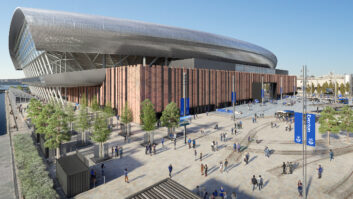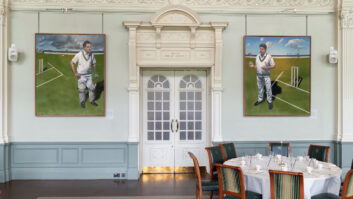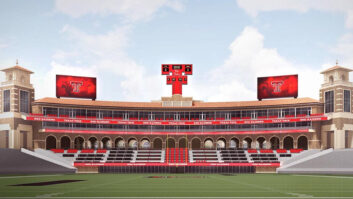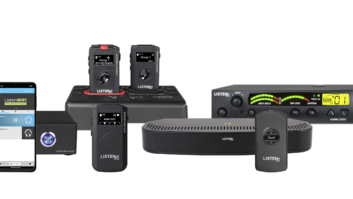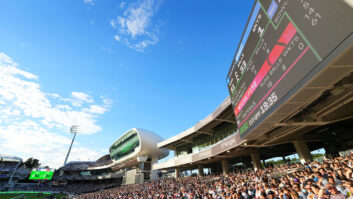Following the debut of Major League Baseball at The London Stadium, European sport is about to face changes that will replace pies and pints with hot dogs and cheerleaders. Fittingly, the arrival of the Boston Red Sox and the New York Yankees took place at the stadium in East London that hosted the Olympics in 2012, an event that did more to push back the frontiers of sports presentation AV than anything before or since.
LED before wicket
The legislation requirements for VA remain the same in all sporting venues worldwide, although interpretations can be different. One thing’s for sure: it’s all about intelligibility. “In cricket, attendance can range from the huge crowds at Melbourne and Sydney, for example, to county cricket with its frequently low revenues – making it hard to justify a wholesale, premium-quality music sound system,” says Stephen ‘Oggi’ Hogg, a director at d&b audiotechnik GB. “They also have fewer hanging points, being very open, resulting in compromised solutions for many stands. But like a lot of US sports, the games allow natural breaks that can be filled with some form of interaction between the sound system and the audience – musical stings, sponsor messages and so on. Those requirements are broadly the same, and there is premiumisation going on.
“After Hillsborough and others, the need to get a message across was recognised but quality wasn’t initially on the agenda. Today, there are considerations of timbre and authority – ensuring a voice that people will respect. In cricket you’ll get this through overlays just on the audience side of the boundary: small groundstacks that can be wheeled out. The ICC Cricket World Cup gets large crowds regularly, so the overlay costs can be justified. On a more regular basis sound, typically, get less priority than floodlights, video screens and signage.”
But if venues do respond to the commercial pressures to generate more revenue, surely they have to consider audio as a key ingredient? “I think we’re in a period of transition,” says Hogg. “There is a holistic requirement for AV, especially in sports arenas, and the ambition is there to achieve it – at least from a new generation of stadium and arena managers who have grown up in a different world from the classic silver-service, three-course meal view of hospitality. Football used to host the ‘community cathedral’, were everybody smoked, had a pie and pint and went home again.
“The desire to embrace available modern technologies is appearing more and more”
Stephen Hogg, d&b audiotechnik
“But it has all moved forward, and the desire to embrace available modern technologies is appearing more and more. Sound may take a bit of a back seat right now, but ultimately it will take its natural place in the new world. For instance, d&b’s R1 as monitoring software is not only able to comply with a legislative component; utilising OCA [Open Control Architecture] enables direct control of the sound system and integration across multiple control platforms and networks. AV integration needs to be thought about early on to make sure you’ve got the right infrastructure and interoperability. The need may be limited in open-bowl stadiums, but the enclosed mega-arenas we’re now seeing developed should undoubtedly be able to embrace that holistic approach to audio, video and projection mapping – and let’s not ignore control of rigging mechanisms, seating and more.”
Powerful draw
Efficiency of power consumption is one of the most important considerations in any stadium, and amplifiers play a central role in this. “Class-D amplifier technology allows for a very dense power pack of amplifiers, which in turn saves a lot of rack space. The key to power efficiency in an amplifier is a very low current draw and thermal dissipation,” explains Francesco Fanicchi, brand & communication director at Powersoft.
Powersoft recently upgraded Dortmund’s Signal Iduna Park Stadium in Germany, resulting in a reported power requirement of just 40% of the previous draw, along with full remote control and remote monitoring. Another example is Lord’s cricket ground in London, where the audio network requires 200-300 amplifier channels. By upgrading to Powersoft, Lord’s not only expanded its audio network dramatically but also reduced its audio power consumption by 90%, according to Fanicchi.
“Safety and crowd management are crucial,” he adds, “while a large and passionate crowd is the objective for every venue. While PA ensures entertainment, the VA will address the crowd in emergencies – at an SPL above the noise generated by supporters. In a combined ‘PAVA’ setup, audio quality is combined with extensive monitoring and control. Entertainment, yes: but most importantly lives are at stake.”
Fanicchi sees a stadium’s existing Ethernet structure as crucial for future products: they will have to work on this backbone. “The key,” he says, “is making sure the amplifier offers a powerful DSP platform while guaranteeing the best audio quality. Digital audio networks like Dante also allow for full integration of the audio system into the venue’s IT system. Another forthcoming trend is decentralised DSP, wherein the DSP is essentially split across the amplifiers so they are better equipped to protect the loudspeakers and monitor the system. By using decentralised DSP we’re also limiting the amount of network traffic and reducing the channel count on the network.”

